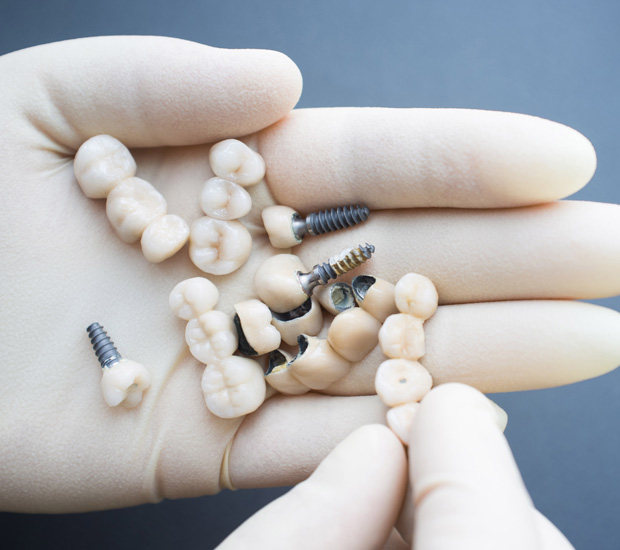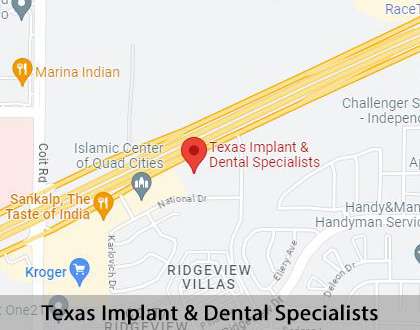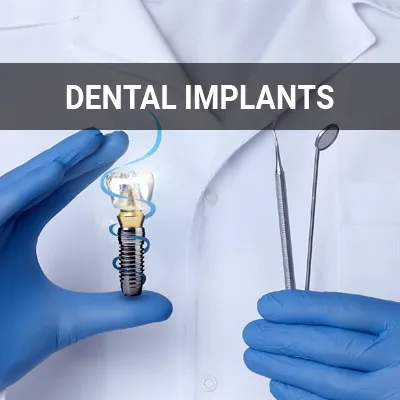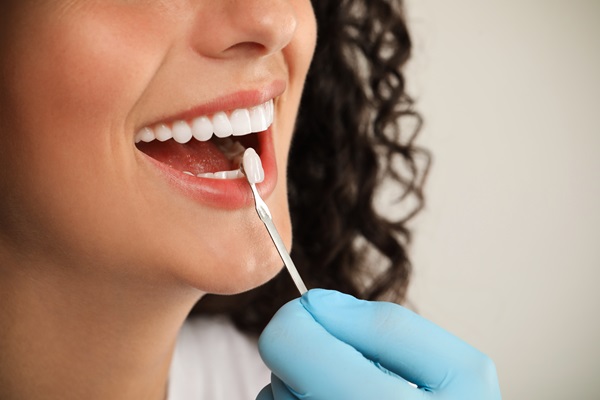Crowns vs. Implants Plano, TX
Dental implants and crowns are popular ways to restore smiles, giving people the chance to restore the natural appearance and function of their teeth. With a variety of excellent options available, no one should have to deal with the hassle of missing or damaged teeth. Our periodontics team looks forward to helping you show off your smile again.
Crowns and implants are available at Texas Implant & Dental Specialists in Plano and the surrounding area. If you are unsure which option best suits you, our team can help you decide. Call our office at (972) 535-6555 to schedule an appointment.
What Is a Dental Crown?
In most cases, a dental crown is a tooth-shaped cap that covers a damaged or misshaped tooth. However, crowns can also cover implants or attach a bridge to adjacent teeth. Crowns often cover large cavities that are too big for traditional fillings or a more vulnerable tooth after a root canal treatment.
Dental crowns can consist of various materials, including ceramic, composite resin, porcelain, metal, zirconia, or a combination of these. The choice of material depends on several factors, including placement and appearance. For example, a periodontist may recommend metal crowns for back molars since they are stronger and less likely to chip when chewing. The appearance is less of a concern since they are not easily seen when a person talks or smiles. If a crown is needed to cover a more visible tooth, porcelain may be a better choice for cosmetic reasons. Lower cost options such as porcelain fused to metal and composite resin can also look like natural teeth.
Getting a traditional crown is typically a two-appointment process that varies slightly depending on the nature of the patient's case. During the first appointment, our team will reshape the tooth and make an impression. We send the impression to the lab, where technicians make the actual crown. The practitioner cements the crown in place on the second visit. It takes two to three weeks for the lab to create the crown, so the patient must wear a temporary crown until the permanent crown is ready.
“Crowns often cover large cavities that are too big for traditional fillings or a more vulnerable tooth after a root canal treatment.”
What Is a Dental Implant?
A dental implant is a titanium screw placed into the jawbone below the gum line to act as a root for a replacement tooth or teeth. Once the implant fuses with the jaw, it is topped with an abutment and then a crown. In addition to supporting a single replacement tooth, implants may support a denture or bridge.
Typically, the process of getting a dental implant takes several months, from beginning to end. The process starts with the complete removal of the tooth and the placement of the titanium post that will serve as the new root. After placement of the titanium post, the patient must wait for three to six months while the post attaches to the jawbone in a process called osseointegration.
Following this, the practitioner will place the abutment. The abutment connects the artificial tooth to the titanium post. The artificial tooth is a crown, except it is being placed over the implant instead of a natural tooth. There are variations in this process depending on the patient's specific case, but this is the overall process.
“In addition to supporting a single replacement tooth, implants may support a denture or bridge.”
Similarities Between Crowns and Implants
Traditional dental crowns and implants offer some of the same benefits and serve some of the same purposes. Both offer options for replacing missing teeth and an alternative to partial dentures. Many patients prefer them because they function and look almost identical to natural teeth. Also, they do not have to be taken out each night and soaked, and there are no glues to deal with. The fact that the patient does not have to worry about traditional or implant-supported bridges slipping or falling out is another attractive benefit.
A dental bridge is a prime example of a dental service that can be accomplished using dental implants or traditional crowns. Typically, a false tooth or pontic flanked on each side by a dental crown make up the bridge. The crowns on each side of the pontic attach to the abutments on each side of the missing tooth. The pontic fills in the gap left by the missing tooth. Before implants, the person's natural teeth served as the abutments. Now, practitioners can use dental implants for abutments in cases where there are no natural teeth to serve as abutments. Though the implants are permanent, the bridge portion will need to be replaced every five to 15 years.
“The fact that the patient does not have to worry about traditional or implant-supported bridges slipping or falling out is another attractive benefit.”
Check out what others are saying about our dental services on Yelp: Crowns vs. Implants in Plano, TX
Differences Between Crowns and Implants
The periodontist considers the patient's unique situation and preferences when advising on choosing between dental crowns or dental implants. If the teeth around the missing tooth site are healthy and intact, traditional crowns are usually the preferred choice. Though implants can be used in place of natural teeth, the underlying jawbone must be in good condition to support the implants. Crowns are the preferred treatment if a natural tooth can be saved and just needs support and protection. If only one tooth is missing and the neighboring teeth are in great condition, it may be more advantageous to use an implant. Using an implant would not require any altering to perfectly healthy teeth.
If several teeth or all of a person's teeth are missing or need removal, full dental implants become a more likely option. There are several types of implant-supported full teeth replacement options on the market. Usually, with this approach, four to six implants support a full set of top and bottom teeth. The number of implants used depends on the patient's situation. The jaw must be in good condition, or the patient must be a candidate for bone grafting for this to be a viable option.
“Crowns are the preferred treatment if a natural tooth can be saved and just needs support and protection.”
Questions Answered on This Page
Q. What is used to make a dental crown?
Q. What are the benefits of dental crowns and dental implants?
Q. How do dental implants and dental crowns differ?
Q. How should one care for their mouth during and after the procedure?
People Also Ask
Q. What types of materials are used for dental crowns?
Q. What are the benefits of dental implants?
Q. What are the types of tooth replacements?
Q. What happens during an extraction procedure?
Q. What is the difference between a dentist and a periodontist?
After-Care for Crowns and Implants
Getting a dental crown tends to be a two-appointment process. The periodontist will first prepare the tooth for the crown and get an impression to send to the lab. Patients will wear a temporary crown that is likely to be acrylic between the first and second appointments. It will not be as strong as the permanent crown, so it is important patients take extra care during this time. For example, avoid hard, sticky, and chewy foods that risk chipping or detaching the crown. The practitioner will offer further advice on how to be careful during this time.
Right after the procedure, patients may still be numb from any anesthetic, and there may be tenderness and bruising in the treatment area. It is a good idea to avoid chewing right after so as not to risk biting the inside of one's cheek or irritating the area. Though there is usually some sensitivity reported during the days following the placement of the permanent crown, it is likely to subside without intervention. Much of the discomfort can be managed with over-the-counter pain relievers.
Continue to avoid sticky foods for 24 hours after the procedure. However, if discomfort continues for several weeks or the bite still feels off after that much time, a dental professional should look into it. Though a rare occurrence, patients should call our office if they have an allergic reaction to the cement or if the crown feels loose or falls off.
Patients do have some control over whether their crown lasts five years or closer to 15. Choosing resin may be a less expensive material choice; however, it will wear down much faster than other options. The better a patient follows a solid daily oral hygiene routine, the longer their dental crowns and other dental work will last. Though the space is too small to notice, it is still there. Patients should regularly clean between the gum and pontic with a floss threader, interdental brush, or water flosser.
Aftercare for Dental Implants
The process of getting dental implants may involve a few different surgeries and recovery periods depending on the patient's needs. The three to six-month healing process after the screw is placed is a given for everyone who has dental implants. If a patient needs bone grafting to prepare the jaw, then it will take about four to six months of healing before placing the implant. Many of the same post-procedure considerations that apply to getting a dental crown apply here as well. Our team will discuss how to manage oral health during these in-between periods.
Typical post-surgery issues include swelling, discomfort at the implant site, and a little bruising. The periodontist may prescribe antibiotics as a precaution, but most of the discomfort can be managed with over-the-counter pain relievers.
Though getting dental implants can be a time commitment, most people report little discomfort during the procedures and are so happy with the results they feel the commitment was worth it. One will want to care for their implants the way they did their natural teeth to avoid gum disease. Though strong and durable, bad oral habits such as teeth grinding and clenching can damage dental implants.
“Though getting dental implants can be a time commitment, most people report little discomfort during the procedures and are so happy with the results they feel the commitment was worth it.”
Frequently Asked Questions
Q. What are some possible complications from getting dental implants?
A. Complications are rare but include sinus issues, nerve damage, teeth and surrounding tissue damage, and infection. Our team can treat these complications if they happen. In addition, there is a 5% chance of implant rejection. However, when rejected implants are replaced, they work over 90% of the time, according to Cleveland Clinic.
Q. Can dental implants and crowns decay?
A. The crown and implants are not subject to decay like natural teeth. However, the gums are still susceptible to gum disease, and the tooth under a crown can still decay. For this reason, oral hygiene remains important. Dental professionals recommend water flossers, interdental brushes, and floss threaders to assist with cleaning around crowns and implants. You will also want to continue routine dental visits.
Q. What is the cost difference between dental crowns and dental implants?
A. Dental implants tend to be significantly more expensive than dental crowns. The difference in cost can range drastically based on the patient's situation. After evaluating your case, our team can discuss the possible options and costs involved with you. Patients should also contact their dental insurance provider to find out about coverage.
Q. What is peri-implantitis?
A. Peri-implantitis is an infectious disease-causing inflammation and bone loss in the area around an implant. It can start with bacteria forming in the gums around the implant and is similar to gum disease. However, peri-implantitis is treatable and avoidable with proper oral hygiene.
Q. Can I whiten my dental crowns or dental implants?
A. This is one area in which natural teeth, crowns, and implants vary greatly. Some materials used to make prosthetic teeth are more resistant to stains than others; however, none of these materials can be whitened by the methods used to whiten natural teeth. Therefore, dental professionals often recommend patients have whitening procedures done before implant or crown work. Our team can discuss this and other cosmetic concerns at your consultation.
Start Feeling Better – Visit Us Today
By visiting us as soon as possible, our team can help get you the professional treatment you need. Instead of waiting around and allowing the symptoms to get worse, we can provide you with treatment options.
Definitions
Call Us Today
If you are looking to restore your smile, consider dental crowns or dental implants. Our team at Texas Implant & Dental Specialists can help you decide which option is right for you. Call us today at (972) 535-6555 to learn more about our services or schedule an appointment.
Helpful Related Links
- American Academy of Periodontology (AAP). American Academy of Periodontology (AAP). 2023
- Center for Disease Control and Prevention (CDC), Periodontal Disease Page. Center for Disease Control and Prevention (CDC), Periodontal Disease Page. 2023
- WebMD, What Is a Periodontist?. WebMD, What Is a Periodontist?. 2023
About our business and website security
- Texas Implant & Dental Specialists was established in 2007.
- We accept the following payment methods: American Express, Cash, Check, Discover, MasterCard, and Visa
- We serve patients from the following counties: Collin County, Denton County and Dallas County
- We serve patients from the following cities: Plano, Frisco, Allen, McKinney, Garland, Richardson, Prosper, Wylie, Murphy, and Dallas
- Norton Safe Web. View Details
- Trend Micro Site Safety Center. View Details
Back to top of Crowns vs. Implants










